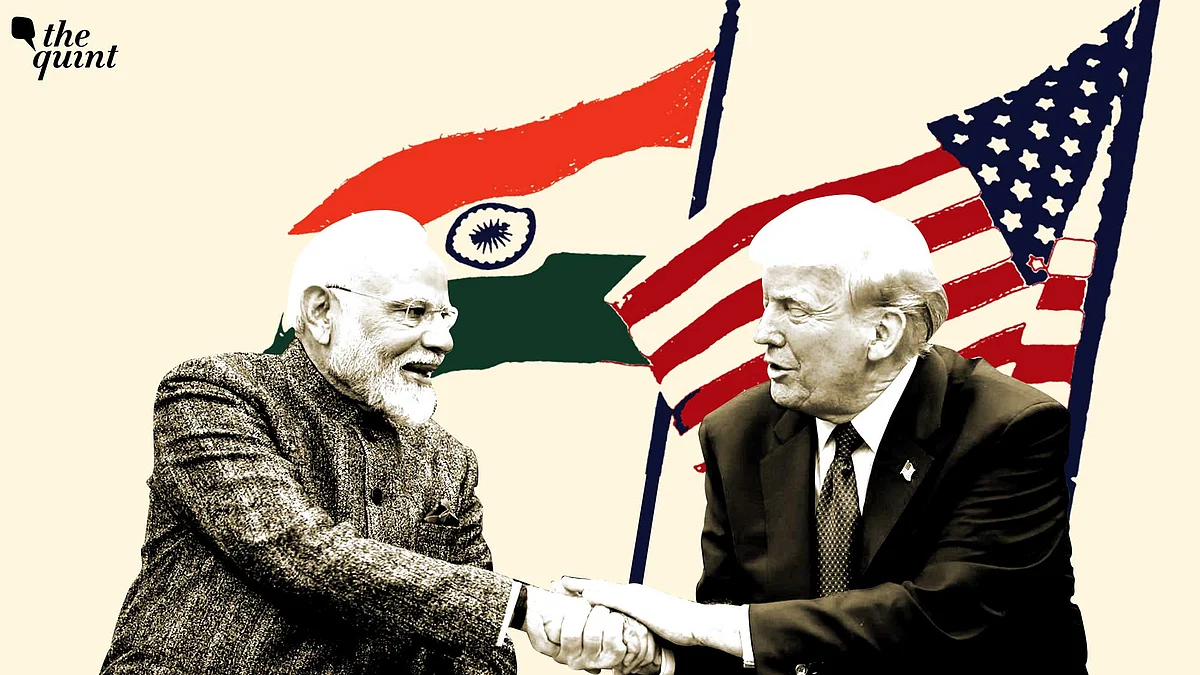
Buy Jets, Make Friends: India Can Gain from Trump's Politics of Disruption
A friendship between Trump and Putin could have a positive fallout for India, writes Sanjeev S Ahluwalia.

advertisement
Benito Mussolini, the Italian fascist, had declared, “War is to a nation what motherhood is to a woman.” He was wrong on motherhood. Pro-choice Italian women have reduced fertility rates from 2.4 percent in 1950 to just 1.31 today—amongst the lowest in Europe.
But he was more accurate on war tempering a nation. Consider Ukraine, which has courageously galvanised an ageing Europe towards self-reliance and strategic autonomy.
President Donald Trump, too, must get some credit for inducing long-term Western allies to bring more to the table.
Trumpism is more in your face about cost-sharing, as illustrated by Trump's offer to support Ukraine with American weapons and nuclear support, conditional on being gifted a part of its mineral wealth. The offer was withdrawn when the Ukranian side refused to be suckered into playing to President Trump’s need for an early win by initiating a peace process in Europe sans an upfront, iron cast long-term security guarantee.
Are Import Tariffs Justified?
Trumpism has revived the 1930 US practice of protective tariffs to protect domestic producers — a strategy which contributed to the “Great Depression”. Are we on the threshold of a similar fate now?
Fortunately, Trumpism is addicted to “shock and awe” negotiating tactics to bludgeon the opposite party into instant compliance. Remaining responsive but with uncrossable red lines clearly drawn, and offering inconsequential concessions such as lower import duties on trucks and heavy motorcycles, as India did, can diffuse the aggression.
The US outgrew the need for tariff protection in the late 1930s, experiencing rapid growth in the 1920s and again in the late 1930s. Income levels are a fair proxy for development needs. In 1935, the US accounted for 35 percent of global GDP (current dollars) compared to 25 per cent in 2024.
High-income countries together account for 64 per cent, upper middle-income economies, including China, account for 28 percent, while lower middle-income countries, including India, account for only seven percent. Tariff protection for countries in the upper-middle-income and high-income ranges has questionable merit. India, still a lower middle-income economy, can justify protective tariffs in specific areas such as agriculture.
Defence and Diplomacy: A Strategic Balancing Act
Trump seems willing to explore a pathway for India to buy F-35 jets, the most expensive fifth-generation stealth fighters, at about $80 million each. In the long term, India needs to ramp up lagging domestic solo and co-production of fighter jets.
Importing them is a medium-term, stop-gap measure. France (Rafale), Russia (Su-57), or the F-35 are options, depending on assurances of timely supply and reasonable life-cycle costs, including the additional cost of further diversifying the fleet.
Another persuasive option to fill air defence gaps at lower cost is missiles and drones, as Ukraine deployed successfully against Russian air power, on the back of US intel and communications support systems.
Trumpism has broken with past policies and seems willing to explore a direct working relationship with Russia, possibly to wean it away from China. This strategy has shocked Europe, much of which covertly did the same with Russia, even as the Ukrainian war raged.
India has never severed its special relationship with Russia, so its strategic aims align with pragmatic Trumpism. If India was capable enough to replace China as a supplier of manufacturing inputs to Russia, Trump’s Russian dance would have had a greater impact.
Trump Nihilism: A Boon for India and China?
Trumpism has severed all global safety nets forged by the developed world since World War II. New ones must be forged; and China, India will both consequently gain from this disruption.
China is the global leader in low-cost supply of manufacturing inputs. It is conceivable that Trumpism might recognise this position of strength and seek a mutually beneficial accommodation, delaying the inevitable clash of the two titans.
For India, the glacial pace of the long-negotiated Free Trade Agreement (FTA) with the European Union (EU) could get momentum as the incentive in Europe, for locking into multiple standalone economic and strategic partnerships, has enhanced.
Trumpism has birthed an opportunity for late-starting economies by disrupting established trade and investment relationships
India was a marginal beneficiary of the established system. Between 1980 to 2023, China benefited to the extent of 23 percent of the increase in global GDP, while only 4.5 per cent accrued to India.
With new global economic relationships now being framed, India is well placed to enhance its share in global GDP growth and trade. A multipolar world order suits India well.
In the confusion and smoke of a trade war, fast-growing trade minnows—such as India, with a mere 1.8 percent share in global merchandise exports—are likely to benefit the most. We can survive a Trumpian disruption.
(Sanjeev S Ahluwalia is a Distinguished Fellow at Chintan Research Foundation [CRF], a former IAS officer and an expert in governance and economic regulation. This is an opinion piece. All views expressed are the author’s own. The Quint neither endorses nor is responsible for them.)
- Access to all paywalled content on site
- Ad-free experience across The Quint
- Early previews of our Special Projects
Published: undefined